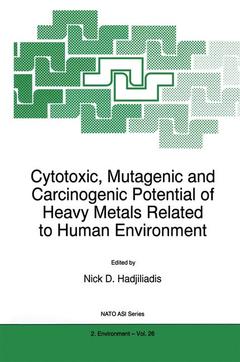Cytotoxic, Mutagenic and Carcinogenic Potential of Heavy Metals Related to Human Environment, Softcover reprint of the original 1st ed. 1997 NATO Science Partnership Subseries: 2 Series, Vol. 26
Langue : Anglais
Coordonnateur : Hadjiliadis N.

Environmental pollution is one of the main problems to confront humanity, with the heavy metals occupying a leading role among the most pernicious pollutants. The metals cause cancer and other sicknesses. Their cytotoxic, mutagenic and carcinogenic potentials are not fully understood, and any thorough investigation demands the combined efforts of scientists drawn from many different disciplines. But the effects of heavy metals are not all negative: some, like cis-DDP, and some ruthenium and tin complexes, have antitumour activity.
The idea underlying the present work is therefore to present a multidisciplinary perspective on heavy metals in the environment, affording a better understanding of their action on human organisms and health, aiming to make them less polluting and more environmentally friendly.
The idea underlying the present work is therefore to present a multidisciplinary perspective on heavy metals in the environment, affording a better understanding of their action on human organisms and health, aiming to make them less polluting and more environmentally friendly.
Metal Carcinogenesis.- Zinc Finger-DNA Interaction: Effect of Metal Replacement, free Radical Generation and DNA Damage and its Relevance to Carcinogenesis.- Pathways in the Chromium(VI)-Mediated Formation of DNA Lesions: A Review.- Approaches to the Biological Monitoring of Chromium(VI) Exposed Individuals.- The Mechanisms of Metal Carcinogenicity Chromium(VI)-induced Genotoxicity: Direct and Indirect Pathways.- The Oxidative Damage Hypothesis of Metal-Induced Genotoxicity and Carcinogenesis.- Effects of Calcium, Magnesium, Zinc and Iron on Nickel Carcinogenesis: Inhibition Versus Enhancement.- Modelling the Metal Binding Sites in Core Histones: Interactions of Carcinogenic Ni(11) with the -CAIH-Motif of Histone H3.- Perinatal Effects of Metals and Cancer in Offspring.- Metallothioneins.- Spectroscopic Properties of Ag(l), Cd(ll), Cu(l), Hg(ll) and Zn(ll) Metallothioneins.- Diversity of Cluster Structures in Mammalian Metallothionein: Interplay Between Metal Ions and Polypeptide Chain.- Metallothionein in Cytotoxicity and Genotoxicity of Metals.- Biological Role of Aluminium.- Aluminium(lll) Speciation and Biological Effects Implications in Human and Experimental Toxicity.- Interaction of Al(lll) with Biomolecules: Bioinorganic Chemistry and Biological Implication.- Complexes of Aluminium(lll) with Biologically Important Ligands.- Bioinorganic Chemistry (General).- Bioinorganic Aspects of Lanthanide(lll) Coordination Chemistry: Modelling the Use of Lanthanides(III) as Probes at Calcium (II) Binding Sites.- From the Mass Production of Methvlococcus Capsulatus to the Efficient Separation and Isolation of Methane Monooxygenase Proteins. Characterization of Novel Intermediates in Substrate Reactions of Methane Monooxygenase.- Modeling Manganese Redox Engymes.- Metal Transport.- Li+ Transport Properties in Perfused Neuronal Cells By 7Li NMR Spectroscopy.- Active Efflux Mechanisms for Cellular Resistance.- Transferrin: A Natural Carrier for Metal Ions and Drugs.- Heavy Metals in the Environment.- Human and Ecological Health Risks from Heavy Metals and Other Substances Released to the Environment from Metal Shredders.- Analytical Applications of Vibrational Spectroscopy in Bioorganometallic Chemistry.- Advanced Techniques for Bioinorganic and Environmental Speciation Analysis for Heavy Metals.- A Heavy Metal Pollution in Industrial Lone and Its Effect on Soil and Spring Water in Iskenderun Bay, North East Mediterranean.- Antitumor Metal Complexes.- Mechanistic Aspects of Pt Antitumor Chemistry.- Factors Affecting Formation and Structure of DNA Intrastrand Cross-Links by Dinuclear Platinum Complexes.- Tin-Based Antitumor Drugs.- Ruthenium-Sulfoxide Complexes with a Specific Antimetastatic Activity.- Synthesis, Spectroscopy and Structures of Complexes of Pd(ll) with 4N-Substituted Derivatives of 2-Acetylpyridine Thiosemicarbazone.- Metal Interactions with Oligonucleotides and Oligopeptides.- Design of Proteins with ATCUN Motif Which Specifically Cleave DNA.- The Binding of Transition Metal Ions to DNA Oligonucleotides Studied by Nuclear Magnetic Resonance Spectroscopy.- Pyrimidine Nucleobases as Versatile and Multidentate Ligands for Heavy Metal Ions. Significance of Metal Binding to the C(5) Sites of Uracil and Cytosine.- Potentiometric and Spectroscopic Studies on the Ternary Complexes of Copper(ll) and Palladium(ll) with Peptides and Nucleobases.- Metal Binding Selectivity of Oligopeptides.- Bioinorganic Chemistry of Toxic Nickel.- Interaction of Platinum(ll), Palladium(ll) and Mercury(ll) Salts with Histidine (His) and/or Cysteine (Cys) Containing Peptides.- General Subjects.- Electrochemical and Chemical Oxidation of K(C2H5OCS2), [Ni(C2H5OCS2)2] and [N(C2H5)4][Ni(C2H5OCS2)3].- Transport of Biomimetic Multinuclear Complexes of Manganese into Environmental Abudant Clays.- Sequential Oligopeptide Carriers (SOCn) for Producing Potent Antigens and Effective Immunogens.
Date de parution : 11-2012
Ouvrage de 629 p.
16x24 cm
Thèmes de Cytotoxic, Mutagenic and Carcinogenic Potential of Heavy... :
© 2024 LAVOISIER S.A.S.



